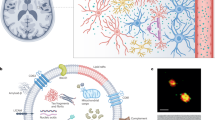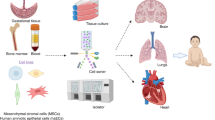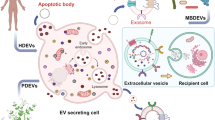Abstract
Extracellular vesicles (EVs) are cell-derived membrane-bound particles, extensively investigated across many fields to improve the understanding of pathophysiological processes, as biomarkers of disease and as therapeutic targets for pharmacological intervention. We aim to describe the current knowledge of EVs detected in the body fluids of human neonates, both term and preterm, from birth to 4 weeks of age. To date, EVs have been described in several neonatal body fluids, including cerebrospinal fluid, umbilical cord blood, neonatal blood, tracheal aspirates and urine. These studies demonstrate some important roles of EVs in the neonatal population, particularly in haemostasis. Moreover, some studies have demonstrated the pathophysiological mechanisms and the identification of potential biomarkers of neonatal disease. We must continue to build on this knowledge, evaluating the role of EVs in neonatal pathology, particularly in prematurity and during the perinatal adaption period. Future studies should use larger numbers, robust EV characterisation techniques and always correlate the findings to clinical outcomes.
Impact
-
This article summarises the current knowledge of the effect of EVs in neonates.
-
It describes the potential compensatory role of EVs in neonatal haemostasis.
-
It also describes the role of EVs as mediators of pathology and as potential biomarkers of perinatal and neonatal disease.
Similar content being viewed by others
Log in or create a free account to read this content
Gain free access to this article, as well as selected content from this journal and more on nature.com
or
References
Lane, R. E. et al. Extracellular vesicles as circulating cancer biomarkers: opportunities and challenges. Clin. Transl. Med. 7, 14–14 (2018).
Murphy, D. E. et al. Extracellular vesicle-based therapeutics: natural versus engineered targeting and trafficking. Exp. Mol. Med. 51, 1–12 (2019).
Iraci, N. et al. Focus on extracellular vesicles: physiological role and signalling properties of extracellular membrane vesicles. Int. J. Mol. Sci. 17, 171–171 (2016).
Théry, C. et al. Minimal information for studies of extracellular vesicles 2018 (MISEV2018): a position statement of the International Society for Extracellular Vesicles and update of the MISEV2014 guidelines. J. Extracell. Vesicles 7, 1535750 (2018).
Yáñez-Mó, M. et al. Biological properties of extracellular vesicles and their physiological functions. J. Extracell. Vesicles 4, 27066–27066 (2015).
van der Pol, E. et al. Classification, functions, and clinical relevance of extracellular vesicles. Pharmacol. Rev. 64, 676–705 (2012).
Berckmans, R. J. et al. Cell-derived microparticles circulate in healthy humans and support low grade thrombin generation. Thromb. Haemost. 85, 639–646 (2001).
Owens, A. P. 3rd & Mackman, N. Microparticles in hemostasis and thrombosis. Circ. Res. 108, 1284–1297 (2011).
Peinado, H. et al. Melanoma exosomes educate bone marrow progenitor cells toward a pro-metastatic phenotype through MET. Nat. Med. 18, 883–891 (2012).
Useckaite, Z. et al. Increased extracellular vesicles mediate inflammatory signalling in cystic fibrosis. Thorax 75, 449–458 (2020).
Akers, J. C. et al. MiR-21 in the extracellular vesicles (EVs) of cerebrospinal fluid (CSF): a platform for glioblastoma biomarker development. PLoS ONE 8, e78115 (2013).
Willis, G. R., Mitsialis, S. A. & Kourembanas, S. “Good things come in small packages”: application of exosome-based therapeutics in neonatal lung injury. Pediatr. Res. 83, 298–307 (2018).
McCulloh, C. J. et al. Treatment of experimental necrotizing enterocolitis with stem cell-derived exosomes. J. Pediatr. Surg. 53, 1215–1220 (2018).
Porzionato, A. et al. Intratracheal administration of clinical-grade mesenchymal stem cell-derived extracellular vesicles reduces lung injury in a rat model of bronchopulmonary dysplasia. Am. J. Physiol. Lung Cell. Mol. Physiol. 316, L6–l19 (2019).
Willis, G. R. et al. Mesenchymal stromal cell exosomes ameliorate experimental bronchopulmonary dysplasia and restore lung function through macrophage immunomodulation. Am. J. Respir. Crit. Care Med. 197, 104–116 (2018).
Xu, W. et al. Exosomes from microglia attenuate photoreceptor injury and neovascularization in an animal model of retinopathy of prematurity. Mol. Ther. Nucleic Acids 16, 778–790 (2019).
Mateescu, B. et al. Obstacles and opportunities in the functional analysis of extracellular vesicle RNA - an ISEV position paper. J. Extracell. Vesicles 6, 1286095 (2017).
Su, S.-A. et al. Emerging role of exosome-mediated intercellular communication in vascular remodeling. Oncotarget 8, 25700–25712 (2017).
Słomka, A. et al. Large extracellular vesicles: have we found the holy grail of inflammation? Front. Immunol. 9, 2723 (2018).
Witwer, K. W. et al. Standardization of sample collection, isolation and analysis methods in extracellular vesicle research. J. Extracell. Vesicles 2, 20360 (2013).
Lötvall, J. et al. Minimal experimental requirements for definition of extracellular vesicles and their functions: a position statement from the International Society for Extracellular Vesicles. J. Extracell. Vesicles 3, 26913–26913 (2014).
Dragovic, R. A. et al. Sizing and phenotyping of cellular vesicles using nanoparticle tracking analysis. Nanomedicine 7, 780–788 (2011).
Perez-Pujol, S., Marker, P. H. & Key, N. S. Platelet microparticles are heterogeneous and highly dependent on the activation mechanism: studies using a new digital flow cytometer. Cytom. Part A 71A, 38–45 (2007).
McKinnon, K. M. Flow cytometry: an overview. Curr. Protoc. Immunol. 120, 5.1.1–5.1.11 (2018).
Awad, H. A. et al. CD144+ endothelial microparticles as a marker of endothelial injury in neonatal ABO blood group incompatibility. Blood Transfus. 12, 250–259 (2014).
van Velzen, J. F. et al. Multicolor flow cytometry for evaluation of platelet surface antigens and activation markers. Thromb. Res. 130, 92–98 (2012).
Carnino, J. M., Lee, H. & Jin, Y. Isolation and characterization of extracellular vesicles from broncho-alveolar lavage fluid: a review and comparison of different methods. Respir. Res. 20, 240 (2019).
Willis, G. R., Kourembanas, S. & Mitsialis, S. A. Therapeutic applications of extracellular vesicles: perspectives from newborn medicine. Methods Mol. Biol. 1660, 409–432 (2017).
Lesage, F. & Thebaud, B. Nanotherapies for micropreemies: stem cells and the secretome in bronchopulmonary dysplasia. Semin. Perinatol. 42, 453–458 (2018).
Matei, A. C., Antounians, L. & Zani, A. Extracellular vesicles as a potential therapy for neonatal conditions: state of the art and challenges in clinical translation. Pharmaceutics 11, 404 (2019).
Michelson, A. D. et al. Platelet and platelet-derived microparticle surface factor V/Va binding in whole blood: differences between neonates and adults. Thromb. Haemost. 84, 689–694 (2000).
Schmugge, M. et al. The relationship of von Willebrand factor binding to activated platelets from healthy neonates and adults. Pediatr. Res. 54, 474–479 (2003).
Wasiluk, A. et al. Platelet-derived microparticles and platelet count in preterm newborns. Fetal Diagn. Ther. 23, 149–152 (2008).
O’Reilly, D. et al. The population of circulating extracellular vesicles dramatically alters after very premature delivery—a previously unrecognised postnatal adaptation process? Blood 132(Suppl. 1), 1129–1129 (2018).
Schweintzger, S. et al. Microparticles in newborn cord blood: slight elevation after normal delivery. Thromb. Res. 128, 62–67 (2011).
Uszyński, M. et al. Microparticles (MPs), tissue factor (TF) and tissue factor inhibitor (TFPI) in cord blood plasma. A preliminary study and literature survey of procoagulant properties of MPs. Eur. J. Obstet. Gynecol. Reprod. Biol. 158, 37–41 (2011).
Hemker, H. C. et al. The calibrated automated thrombogram (CAT): a universal routine test for hyper- and hypocoagulability. Pathophysiol. Haemost. Thromb. 32, 249–253 (2002).
Karlaftis, V. et al. The microparticle-specific procoagulant phospholipid activity changes with age. Int. J. Lab Hematol. 36, e41–e43 (2014).
Campello, E. et al. Circulating microparticles in umbilical cord blood in normal pregnancy and pregnancy with preeclampsia. Thromb. Res. 136, 427–431 (2015).
Korbal, P. et al. Evaluation of tissue factor bearing microparticles in the cord blood of preterm and term newborns. Thromb. Res. 153, 95–96 (2017).
Zhu, X. J., Wei, J. K. & Zhang, C. M. Evaluation of endothelial microparticles as a prognostic marker in hemolytic disease of the newborn in China. J. Int. Med. Res. 47, 5732–5739 (2019).
Vitkova, V. et al. Endothelial microvesicles and soluble markers of endothelial injury in critically ill newborns. Mediat. Inflamm. 2018, 1975056 (2018).
Meyer, A. D. et al. Effect of blood flow on platelets, leukocytes, and extracellular vesicles in thrombosis of simulated neonatal extracorporeal circulation. J. Thromb. Haemost. 18, 399–410 (2020).
Horbar, J. D. et al. Mortality and neonatal morbidity among infants 501 to 1500 grams from 2000 to 2009. Pediatrics 129, 1019–1026 (2012).
Lal, C. V. et al. Exosomal microRNA predicts and protects against severe bronchopulmonary dysplasia in extremely premature infants. JCI Insight 3, e93994 (2018).
Go, H. et al. Extracellular vesicle miRNA-21 is a potential biomarker for predicting chronic lung disease in premature infants. Am. J. Physiol. Lung Cell. Mol. Physiol. 318, L845–L851 (2020).
Tietje, A. et al. Cerebrospinal fluid extracellular vesicles undergo age dependent declines and contain known and novel non-coding RNAs. PLoS ONE 9, e113116 (2014).
Tagin, M. A. et al. Hypothermia for neonatal hypoxic ischemic encephalopathy: an updated systematic review and meta-analysis. Arch. Pediatr. Adolesc. Med. 166, 558–566 (2012).
Goetzl, L. et al. Diagnostic potential of neural exosome cargo as biomarkers for acute brain injury. Ann. Clin. Transl. Neurol. 5, 4–10 (2018).
Spaull, R. et al. Exosomes populate the cerebrospinal fluid of preterm infants with post-haemorrhagic hydrocephalus. Int. J. Dev. Neurosci. 73, 59–65 (2019).
Adams-Chapman, I. et al. Neurodevelopmental outcome of extremely low birth weight infants with posthemorrhagic hydrocephalus requiring shunt insertion. Pediatrics 121, e1167–e1177 (2008).
Marell, P. S. et al. Cord blood-derived exosomal CNTN2 and BDNF: potential molecular markers for brain health of neonates at risk for iron deficiency. Nutrients 11, 2478 (2019).
Khan, N. et al. Impact of new definitions of pre-eclampsia on incidence and performance of first-trimester screening. Ultrasound Obstet. Gynecol. 55, 50–57 (2020).
Lamarca, B. Endothelial dysfunction. An important mediator in the pathophysiology of hypertension during pre-eclampsia. Miner. Ginecol. 64, 309–320 (2012).
Hewitt, B. G. & Newnham, J. P. A review of the obstetric and medical complications leading to the delivery of infants of very low birthweight. Med. J. Aust. 149, 234, 236, 238 passim (1988).
Basso, O. et al. Trends in fetal and infant survival following preeclampsia. JAMA 296, 1357–1362 (2006).
Jia, R. et al. Comparative proteomic profile of the human umbilical cord blood exosomes between normal and preeclampsia pregnancies with high-resolution mass spectrometry. Cell. Physiol. Biochem. 36, 2299–2306 (2015).
Xueya, Z. et al. Exosomal encapsulation of miR-125a-5p inhibited trophoblast cell migration and proliferation by regulating the expression of VEGFA in preeclampsia. Biochem. Biophys. Res. Commun. 525, 646–653 (2020).
March of Dimes, PMNCH, Save the Children, World Health Organisation. in Born Too Soon: The Global Action Report on Preterm Birth (eds Howson, C. P., Kinney, M. V. & Lawn, J. E.) (World Health Organisation, Geneva, 2012).
Patel, R. M. Short- and long-term outcomes for extremely preterm infants. Am. J. Perinatol. 33, 318–328 (2016).
Bruschi, M. et al. Association between maternal omega-3 polyunsaturated fatty acids supplementation and preterm delivery: a proteomic study. FASEB J. 34, 6322–6334 (2020).
Lausman, A. & Kingdom, J. Intrauterine growth restriction: screening, diagnosis, and management. J. Obstet. Gynaecol. Can. 35, 741–748 (2013).
Sharma, D., Shastri, S. & Sharma, P. Intrauterine growth restriction: antenatal and postnatal aspects. clinical medicine insights. Pediatrics 10, 67–83 (2016).
Miranda, J. et al. Placental exosomes profile in maternal and fetal circulation in intrauterine growth restriction—liquid biopsies to monitoring fetal growth. Placenta 64, 34–43 (2018).
Ng, A. P. & Alexander, W. S. Haematopoietic stem cells: past, present and future. Cell Death Discov. 3, 17002 (2017).
Hordyjewska, A., Popiołek & Horecka, A. Characteristics of hematopoietic stem cells of umbilical cord blood. Cytotechnology 67, 387–396 (2015).
Xagorari, A. et al. Identification of miRNAs from stem cell derived microparticles in umbilical cord blood. Exp. Hematol. 80, 21–26 (2019).
Huang, S. et al. Comparative profiling of exosomal miRNAs in human adult peripheral and umbilical cord blood plasma by deep sequencing. Epigenomics 12, 825–842 (2020).
Brennan, G. P. et al. RNA-sequencing analysis of umbilical cord plasma microRNAs from healthy newborns. PLoS ONE 13, e0207952 (2018).
Wang, D. J. et al. Lactation-related microRNA expression in microvesicles of human umbilical cord blood. Med. Sci. Monit. 22, 4542–4554 (2016).
Keller, S. et al. CD24 is a marker of exosomes secreted into urine and amniotic fluid. Kidney Int. 72, 1095–1102 (2007).
Stoll, B. J. et al. Neonatal outcomes of extremely preterm infants from the NICHD Neonatal Research Network. Pediatrics 126, 443–456 (2010).
Neary, E. et al. Coagulation indices in very preterm infants from cord blood and postnatal samples. J. Thromb. Haemost. 13, 2021–2030 (2015).
Andrew, M. et al. Development of the human coagulation system in the healthy premature infant. Blood 72, 1651–1657 (1988).
Kettner, S. C. et al. Heparinase-modified thrombelastography in term and preterm neonates. Anesth. Analg. 98, 1650–1652 (2004). table of contents.
Tripodi, A. et al. Normal thrombin generation in neonates in spite of prolonged conventional coagulation tests. Haematologica 93, 1256–1259 (2008).
Schmidt, B. & Andrew, M. Neonatal thrombosis: report of a prospective Canadian and international registry. Pediatrics 96(Part 1), 939–943 (1995).
Dubbink-Verheij, G. H. et al. Thrombosis after umbilical venous catheterisation: prospective study with serial ultrasound. Arch. Dis. Child Fetal Neonatal Ed. 105, 299–303 (2020).
Shah, V. S. et al. Early administration of inhaled corticosteroids for preventing chronic lung disease in very low birth weight preterm neonates. Cochrane Database Syst. Rev. 1, Cd001969 (2017).
Howie, S. R. Blood sample volumes in child health research: review of safe limits. Bull. World Health Organ. 89, 46–53 (2011).
Munro, A. et al. Obstetrical and neonatal factors associated with optimal public banking of umbilical cord blood in the context of delayed cord clamping. Clin. Invest. Med. 42, E56–E63 (2019).
Wisgrill, L. et al. Peripheral blood microvesicles secretion is influenced by storage time, temperature, and anticoagulants. Cytom. A 89, 663–672 (2016).
Fendl, B. et al. Characterization of extracellular vesicles in whole blood: influence of pre-analytical parameters and visualization of vesicle-cell interactions using imaging flow cytometry. Biochem. Biophys. Res. Commun. 478, 168–173 (2016).
György, B. et al. Improved circulating microparticle analysis in acid-citrate dextrose (ACD) anticoagulant tube. Thromb. Res. 133, 285–292 (2014).
Lacroix, R. et al. Impact of pre-analytical parameters on the measurement of circulating microparticles: towards standardization of protocol. J. Thromb. Haemost. 10, 437–446 (2012).
Acknowledgements
This review was funded by a grant from the National Children’s Research Centre, Dublin, Ireland.
Author information
Authors and Affiliations
Contributions
C.A.M., D.P.O’R., E.N., A.E.-K., F.N., P.B.M., and N.M. contributed to the conception, interpretation of data, revision of the article, and final approval of the article. C.A.M. designed, acquired the data, analysed the information, and drafted the manuscript.
Corresponding author
Ethics declarations
Competing interests
The authors declare no competing interests.
Additional information
Publisher’s note Springer Nature remains neutral with regard to jurisdictional claims in published maps and institutional affiliations.
Supplementary information
Rights and permissions
About this article
Cite this article
Murphy, C.A., O’Reilly, D.P., Neary, E. et al. A review of the role of extracellular vesicles in neonatal physiology and pathology. Pediatr Res 90, 289–299 (2021). https://doi.org/10.1038/s41390-020-01240-5
Received:
Revised:
Accepted:
Published:
Issue date:
DOI: https://doi.org/10.1038/s41390-020-01240-5



